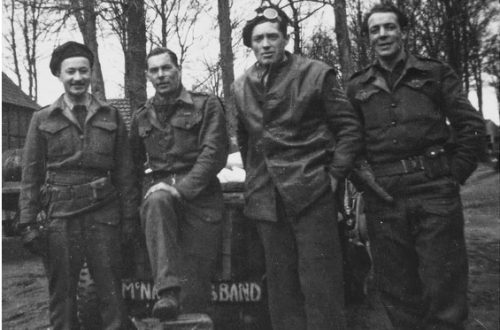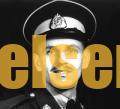Sol Goldberg – First Canadian Army
Growing up the fourth of six children of a poor immigrant Jewish family in Depression-era Hamilton, Ont., Sol Goldberg had to leave high school early to help support the family financially.
Conscripted in the fall of 1944, he was deployed with the First Canadian Army as it moved northward through Europe, assisting in the liberation of Nazi-occupied Belgium and Holland on the way to the ultimate target: Germany.
Pte. 1st Class Goldberg was detailed to a mobile shower and laundry unit. Not glamorous work, but to Sol, a duty assigned was a duty to be performed to the best of one’s ability. Sol’s true heroism, though, is reflected in his ingenuity and leadership in surreptitiously facilitating the delivery of vital material support to the Jewish survivors of the former Bergen-Belsen concentration camp.
Bergen-Belsen was liberated by the British Army on April 15, 1945. Canadian forces arrived within hours to provide vital medical and logistical support. Canadian military personnel soon visited the camp, officially or informally, from surrounding army and air bases. Sol, who was stationed at Celle, the town closest to Bergen-Belsen, was among them, as evidenced by his collection of vivid photographs of barracks, mass graves and crematoria ovens.
Only one generation removed from his parents’ eastern European roots, it was perhaps inevitable that Sol, like many other Allied Jewish soldiers, would be deeply affected by such close encounters with the aftershocks of Nazi atrocity. Frustrated by the slow pace of delivery of essential relief supplies to survivors through official channels, Sol created an alternate informal route. Discovering latent skills for logistics, conniving and scrounging, Sol became the unofficial quartermaster for the acquisition and distribution of supplies to support the survivors, through means that assiduously avoided the bureaucratic delays of the official approach.
Word was communicated among the network of Jewish soldiers and airmen stationed in the region surrounding Bergen-Belsen. Supplies – including essentials such as blankets, clothing, boots, crackers, and canned milk, along with “luxury” items such as cigarettes and chocolates – soon reached Sol, enough to fill the empty Quonset hut over which he had finagled temporary control.
He secretly cut a hole in the former concentration camp’s fences and began to smuggle the supplies directly to the survivors, whose trust he had gradually gained by conversing with them in fluent Yiddish.
Sol also persuaded a Canadian forces medical unit to temporarily transfer an entire operating theatre to him for use in treating the survivors. He understood that he was illegally “reallocating” Canadian military property and that, if caught, he could end up in the stockade or, worse, incarcerated in a civilian prison back in Canada.
(In fact, he was once caught smuggling material into the camp. But, rather than reprimanding him, his commanding officers told Sol to take whatever he needed and arranged for additional supplies to be provided to him to support the Jews residing at the displaced persons camp that had arisen on the site of the former concentration camp.)
One of Sol’s wartime heroic acts had to be undertaken with maximum vigilance: the provision of backpacks to groups involved in the underground transport of Holocaust survivors from Europe to pre-state Israel. Supporting Zionist activity was doubly threatening for Sol. Not only was he illegally transferring Canadian military property, he was also supporting activity that violated Canada’s official position toward the Middle East, which at the time was to endorse British policy in Palestine (including the onerous restrictions on Jewish immigration).
Sol’s skills in logistics and planning – along with his fluency in Yiddish – were recognized as significant assets by external agencies. When he was demobilized from the Canadian Army in late August 1946, he was asked by the United Nations Refugee Relief Agency (UNRRA) to stay on in Europe and work with Holocaust survivors in the DP camps scattered throughout the continent. But Sol chose to return to Canada and try to resume a normal life detached from the wartime chaos and atrocities he had witnessed.
He never spoke much to his family about his wartime activities. Some of the details, began to leak out only some six decades later. Was this because he had chosen to repress the wartime horrors he had witnessed? Or perhaps because Sol did not consider his actions extraordinary?
Despite the memories of Belsen that always haunted him, Sol Goldberg built a happy, normal postwar life. He married a Toronto girl to whom he was blissfully wed for almost 50 years. He was a loving father to two children in whose accomplishments he took tremendous pride. And he was the doting grandfather to three young ladies who became the centre of his existence.
Through a life filled with remarkable courage and generosity under extraordinary circumstances, Sol Goldberg epitomized heroism.
The Canadian Jewish News, December, 2016
6,219 total views


